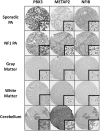MicroRNA profiling in pediatric pilocytic astrocytoma reveals biologically relevant targets, including PBX3, NFIB, and METAP2
- PMID: 23161775
- PMCID: PMC3534421
- DOI: 10.1093/neuonc/nos269
MicroRNA profiling in pediatric pilocytic astrocytoma reveals biologically relevant targets, including PBX3, NFIB, and METAP2
Abstract
Pilocytic astrocytoma (PA) is a World Health Organization grade I glioma that occurs most commonly in children and young adults. Specific genetic alterations have been described in PA, but the pathogenesis remains poorly understood. We studied microRNA (miRNA) alterations in a large cohort of patients with PA. A total of 43 PA, including 35 sporadic grade I PA, 4 neurofibromatosis-1 (NF1)-associated PA, and 4 PA with pilomyxoid features, as well as 5 nonneoplastic brain controls were examined. BRAF fusion status was assessed in most cases. RNA was examined using the Agilent Human miRNA Microarray V3 platform. Expression of miRNA subsets was validated using quantitative real-time PCR (qRT-PCR) with Taqman probes. Validation of predicted protein targets was performed on tissue microarrays with the use of immunohistochemistry. We identified a subset of miRNAs that were differentially expressed in pediatric PAs versus normal brain tissue: 13 miRNAs were underexpressed, and 20 miRNAs were overexpressed in tumors. Differences were validated by qRT-PCR in a subset, with mean fold change in tumor versus brain of -17 (miR-124), -15 (miR-129), and 19.8 (miR-21). Searching for predicted protein targets in Targetscan, we identified a number of known and putative oncogenes that were predicted targets of miRNA sets relatively underexpressed in PA. Predicted targets with increased expression at the mRNA and/or protein level in PA included PBX3, METAP2, and NFIB. A unique miRNA profile exists in PA, compared with brain tissue. These miRNAs and their targets may play a role in the pathogenesis of PA.
Figures





Similar articles
-
MicroRNA profile of pediatric pilocytic astrocytomas identifies two tumor-specific signatures when compared to non-neoplastic white matter.J Neurooncol. 2019 Jan;141(2):373-382. doi: 10.1007/s11060-018-03042-6. Epub 2018 Dec 20. J Neurooncol. 2019. PMID: 30570705
-
miR-15a and miR-24-1 as putative prognostic microRNA signatures for pediatric pilocytic astrocytomas and ependymomas.Tumour Biol. 2016 Jul;37(7):9887-97. doi: 10.1007/s13277-016-4903-7. Epub 2016 Jan 26. Tumour Biol. 2016. PMID: 26813564
-
Gene expression profiling of NF-1-associated and sporadic pilocytic astrocytoma identifies aldehyde dehydrogenase 1 family member L1 (ALDH1L1) as an underexpressed candidate biomarker in aggressive subtypes.J Neuropathol Exp Neurol. 2008 Dec;67(12):1194-204. doi: 10.1097/NEN.0b013e31818fbe1e. J Neuropathol Exp Neurol. 2008. PMID: 19018242 Free PMC article.
-
MiRNA expression profiling in human gliomas: upregulated miR-363 increases cell survival and proliferation.Tumour Biol. 2016 Oct;37(10):14035-14048. doi: 10.1007/s13277-016-5273-x. Epub 2016 Aug 6. Tumour Biol. 2016. PMID: 27495233
-
Using microbial metalo-aminopeptidases as targets in human infectious diseases.Microb Cell. 2021 Aug 9;8(10):239-246. doi: 10.15698/mic2021.10.761. eCollection 2021 Oct 4. Microb Cell. 2021. PMID: 34692819 Free PMC article. Review.
Cited by
-
MiR-1248: a new prognostic biomarker able to identify supratentorial hemispheric pediatric low-grade gliomas patients associated with progression.Biomark Res. 2022 Jun 17;10(1):44. doi: 10.1186/s40364-022-00389-x. Biomark Res. 2022. PMID: 35715818 Free PMC article.
-
The Oncogenic Relevance of miR-17-92 Cluster and Its Paralogous miR-106b-25 and miR-106a-363 Clusters in Brain Tumors.Int J Mol Sci. 2018 Mar 16;19(3):879. doi: 10.3390/ijms19030879. Int J Mol Sci. 2018. PMID: 29547527 Free PMC article. Review.
-
Non-Coding RNA and Tumor Development in Neurofibromatosis Type 1: ANRIL Rs2151280 Is Associated with Optic Glioma Development and a Mild Phenotype in Neurofibromatosis Type 1 Patients.Genes (Basel). 2019 Nov 5;10(11):892. doi: 10.3390/genes10110892. Genes (Basel). 2019. PMID: 31694342 Free PMC article. Review.
-
The role of miR-320a and IL-1β in human chondrocyte degradation.Bone Joint Res. 2017 Apr;6(4):196-203. doi: 10.1302/2046-3758.64.BJR-2016-0224.R1. Bone Joint Res. 2017. PMID: 28404547 Free PMC article.
-
Screening genes crucial for pediatric pilocytic astrocytoma using weighted gene coexpression network analysis combined with methylation data analysis.Cancer Gene Ther. 2014 Oct;21(10):448-55. doi: 10.1038/cgt.2014.49. Epub 2014 Sep 26. Cancer Gene Ther. 2014. Retraction in: Cancer Gene Ther. 2016 Feb-Mar;23(2-3):72. doi: 10.1038/cgt.2015.70. PMID: 25257306 Retracted.
References
-
- Tihan T, Fisher PG, Kepner JL, et al. Pediatric astrocytomas with monomorphous pilomyxoid features and a less favorable outcome. J Neuropathol Exp Neurol. 1999;58(10):1061–1068. - PubMed
-
- Rodriguez FJ, Scheithauer BW, Burger PC, Jenkins S, Giannini C. Anaplasia in pilocytic astrocytoma predicts aggressive behavior. Am J Surg Pathol. 2010;34(2):147–160. - PubMed
-
- Bar EE, Lin A, Tihan T, Burger PC, Eberhart CG. Frequent gains at chromosome 7q34 involving BRAF in pilocytic astrocytoma. J Neuropathol Exp Neurol. 2008;67(9):878–887. - PubMed
Publication types
MeSH terms
Substances
Grants and funding
LinkOut - more resources
Full Text Sources
Other Literature Sources
Research Materials
Miscellaneous

